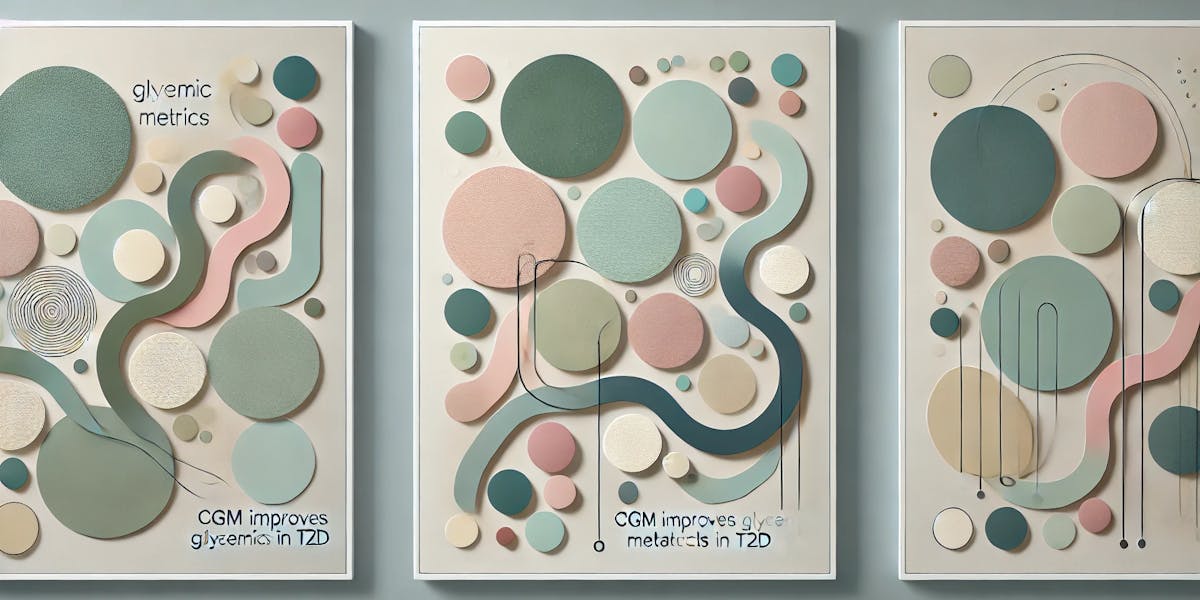CGM improves glycemic metrics in T2D
The Journal of Clinical Endocrinology & Metabolism

Summary
This systematic review and meta-analysis examined the effectiveness of continuous glucose monitoring (CGM) in adults with type 2 diabetes mellitus (T2DM). It pooled data from 14 randomized controlled trials involving a total of 1,647 patients. The review compared two forms of CGM—real-time CGM (rt-CGM) and flash CGM (FGM)—against self-monitoring of blood glucose (SMBG). Findings showed that both rt-CGM and FGM yielded modest but statistically significant reductions in HbA1c (approximately 0.32% overall), indicating improved glycemic control. The benefits were consistent across both CGM types, though rt-CGM showed slightly better improvements in secondary glucose metrics such as time in range and time in hyperglycemia. Despite these positive findings, the studies had relatively short follow-up periods (ranging from 10 to 52 weeks) and often lacked data on critical clinical outcomes like adverse events or hospitalizations. The authors concluded that while CGM can improve short-term glycemic metrics in T2DM patients, longer-term trials are necessary to assess its broader clinical utility and cost-effectiveness. The review used rigorous inclusion criteria, GRADE methodology for certainty assessment, and Cochrane risk-of-bias tools to ensure robust data synthesis.
Study Design
Interventions
Study Type
Outcomes
Duration and Size
Study Population
Age Range
Sex
Geography
Other Criteria
Methodology
The review systematically identified and synthesized randomized controlled trials (RCTs) assessing the effects of CGM versus SMBG in T2DM patients. Studies were selected using predefined inclusion/exclusion criteria and screened in duplicate. Data were extracted on patient characteristics, types of CGM, outcomes (HbA1c, time in range, time in hyper/hypoglycemia), and intervention details. Risk of bias was assessed using the Cochrane ROB 2.0 tool. Meta-analysis was conducted using random-effects models with Hartung-Knapp-Sidik-Jonkman adjustments to account for variability and heterogeneity.
GRADE methodology was applied to assess certainty of evidence across outcomes. Funnel plots and Egger regression were used to assess publication bias. Subgroup and sensitivity analyses were performed based on insulin use, baseline HbA1c, and diabetes duration. The data synthesis focused on percentage mean differences and confidence intervals for glycemic outcomes.
Interventions
Interventions included the use of real-time CGM (Dexcom G4, G6, 7, etc.) and flash CGM (FreeStyle Libre, Libre Pro) as alternatives to SMBG. Devices varied in terms of duration, training provided, and frequency of data collection. Some trials used episodic CGM, while others applied continuous use. CGM was used either blinded or unblinded, depending on the study. Most interventions aimed at optimizing diabetes self-management by offering patients real-time data for glucose trends and alerts, improving behavioral responses to glycemic fluctuations.
Key Findings
CGM use in T2DM resulted in modest yet statistically significant HbA1c reductions (approximately 0.32%), with both rt-CGM and FGM yielding similar results. rt-CGM showed an 11% increase in time in range, though changes in time in hyperglycemia and hypoglycemia were not consistently significant. The certainty of evidence was moderate for primary outcomes, and patient satisfaction was generally favorable. However, longer-term outcomes and adverse event reporting were limited across included trials, suggesting the need for extended studies to assess clinical impact and cost-effectiveness more fully.
Comparison with other Studies
Previous studies primarily focused on CGM in type 1 diabetes populations, where consistent benefits in glucose control and hypoglycemia prevention were reported. This review contrasts by focusing on T2DM patients, a more diverse group in terms of treatment regimens and glycemic variability. Compared to earlier meta-analyses, this study included more recent trials and employed robust sensitivity analysis and bias assessment. The findings are aligned with prior small-scale studies and reviews but provide stronger evidence by aggregating a larger sample with improved methodological rigor.
While this review confirms the HbA1c-lowering benefit of CGM in T2DM, it also highlights variability in hypoglycemia outcomes and limited evidence for long-term benefits such as reduced complications or hospital visits. These inconsistencies were also noted in prior work, which emphasized the importance of subgroup stratification. By focusing on adults using mixed treatment regimens and analyzing rt-CGM and FGM separately, the current study provides a clearer picture of CGM's role across a wider clinical landscape.
Journal Reference
Uhl S, Choure A, Rouse B, Loblack A, Reaven P. Effectiveness of Continuous Glucose Monitoring on Metrics of Glycemic Control in Type 2 Diabetes Mellitus: A Systematic Review and Meta-analysis of Randomized Controlled Trials. J Clin Endocrinol Metab. 2024;109(4):1119–1131. doi:10.1210/clinem/dgad652
© 2025 deDiabetes. Licensed under CC0 (Public Domain)
Stay informed. Stay ahead.
Subscribe now for the latest breakthroughs, expert insights, and cutting-edge updates in diabetes care—delivered straight to your inbox.